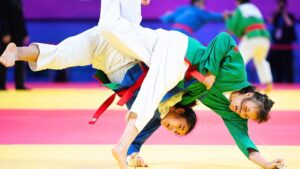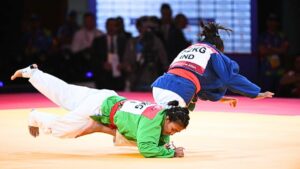Kurash is a type of martial art that originated in Uzbekistan. It is similar to wrestling but with some key differences. The objective of the sport is to throw your opponent onto their back, pin them, or force them out of the ring.
Also Read: History of Kurash at the Asian Games
Kurash matches usually occur on a mat, with two competitors facing each other. The match begins with both competitors holding onto each other’s belts, aiming to throw their opponent to the ground using a towel. If a throw is successful, the thrower earns points, and the match continues.
Kurash is a popular sport in Central Asia and is also gaining popularity in other parts of the world. Known for its fast-paced action and thrilling throws, it is a sport both exciting to watch and participate in.
The first official Kurash Championship occurred in 1928 in Kazan. The championship was a massive success. Since 1956, they have organised regular Tatar Koras competitions in honour of their national hero and poet, Musa Calil.
The third World Championship in Kazan in May 2010 had approximately 100 wrestlers from 17 countries participating. Kurash debuted successfully at the 2018 Asian Games held in Jakarta and Palembang, Indonesia.
Kurash Rules and Regulations
Kurash operates under rules and regulations that dictate how the sport is played. These rules are in place to ensure fair and safe competition.
- Competitors must wear appropriate clothing, such as a tight-fitting shirt and shorts.
- Competitors must not use any moves that could cause injury to their opponent, such as choking or striking.
- The athlete wins the match by throwing the opponent onto their back, pinning them for five seconds, or forcing them out of the ring.
- If a competitor commits a foul, such as using an illegal move, they may receive a warning or be disqualified from the match.
- In Kurash, wrestlers employ various wrestling styles. Referees assess these techniques and award points based on the type used.
- If the wrestlers achieve identical scores, the most recent evaluation by the referees or judges determines the winner.
- If a participant receives an evaluation and a warning in the same match, the assessment precedes the warning.
- If both wrestlers receive equal warnings during the match, the winner is the wrestler who received the first warning.
- Kurash competitions follow a traditional knock-out system without any repechage fights.
- In Kurash, moves that begin inside the tatami and end outside of it are also evaluated.
- Before the match begins, three referees (an arbitrator and two referees) come together at the edge of the tatami, bow down, and take their positions.
- At the end of the match, referees step off the tatami, come together at the edge, and bow down again.
- Participants perform all bows by bending at the waist and leaning forward. If the participants neglect to bow, the referees must execute the bow.
- Wrestlers must wear only shorts or swimming trunks during the weigh-in.
- Kurash uniforms must be made of cotton, be in good condition, and not be too rigid or thick.
- Participants should wear a dark blue or green “Yakhtak” with white trousers and a red belt.
- The first participant, called by the referee, wears a dark blue dressing gown, while the second participant wears a green dressing gown.
- Both male and female wrestlers compete barefoot in Kurash.
- The Kurash tatami should be a minimum of 14×14 meters and a maximum of 16×16 meters.
- Tamami should be green, white, red, light green, or dark blue, and there is a danger zone beyond the red line, which is 1 meter wide.





